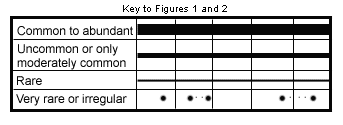

Baird's Sandpiper (Calidris bairdii). Uncommon to rare spring migrant, primarily along coast; scarcer and more local inland. Spring transients occur early March to mid-May, occasionally to late May and early June, peaking in mid-April. Uncommon fall migrant, primarily along coast; scarcer inland. Juvenals occur mid-August through mid-October; occasionally to early November; adults very rare in fall (mid-July through late August). Prefers drier areas than other Calidris including tilled fields, high tide line of beaches, bare dirt. No summering or winter records.
Pectoral Sandpiper (Calidris melanotos). Common to abundant migrant throughout state. Spring transients occur late February to early June, rarely early February and mid-June, peaking in April. Fall migrants occur mid-July to early October, rarely early July and November, peaking in mid- to late August (two early and one late December record may pertain to late migrant or wintering birds); juvenals arrive mid-August. No January or summering records. Marshes, mudflats, flooded fields, and other wet grassy areas.
Purple Sandpiper (Calidris maritima). Vagrant; only a few records (Cameron and Jefferson parishes) from winter and spring. Rocky shoreline or jetties.
Curlew Sandpiper (Calidris ferruginea). Vagrant; only a few records from SW Louisiana from late May and August-September. Mudflats.
Stilt Sandpiper (Calidris himantopus). Common to abundant migrant throughout state. Spring transients occur early March through late May, occasionally to mid-June; migration peak in mid-April and early May. Common fall migrant, arriving early July (adults) and present through late October, occasionally into November; juvenals arrive mid-August. Small numbers regularly winter, especially in SW Louisiana (also recently in south-central and SE Louisiana). No summering records (late June). Edges of ponds, flooded fields, mudflats.

Common to abundant. Large numbers are easily found, at least locally.
Uncommon or only moderately common. Found regularly, but in smaller numbers.
Rare. Found infrequently, not every day, or very localized, but to be expected, particularly at certain times of the year.
Very rare or irregular. Vagrants. Smaller dots indicate presence over a period.